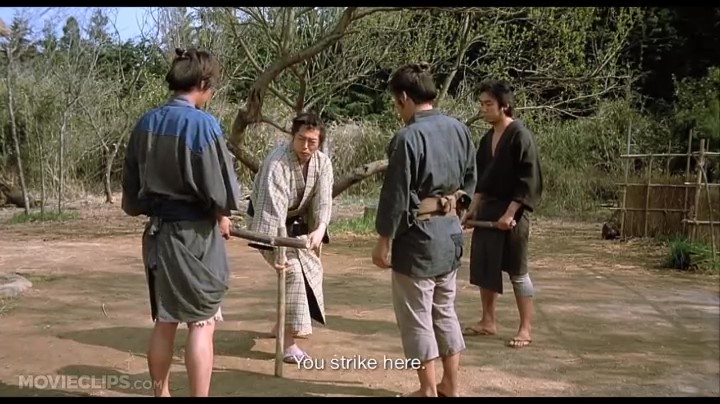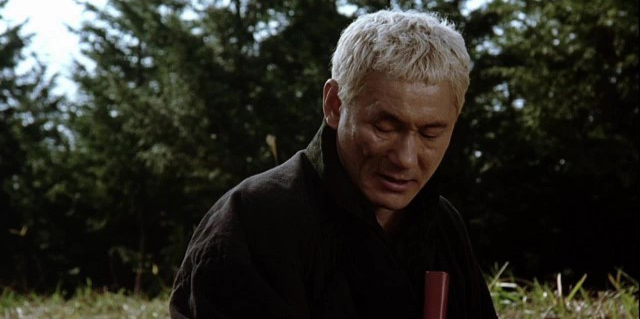
1 No easy prey
How to take a stick from a blind man. (A sword blade is hidden in the stick.)
座頭市

How to take a stick from a blind man. (A sword blade is hidden in the stick.)

Brother and sister survive as artists after losing their entire family in a malicious robbery years ago.

The bon vivant has discovered the virtues of sword fighting and wants to pass them on right away. In addition, a somewhat disturbed young fan of Samurai appears.

Everything will be fine. The party for the finale.
Title: Zatōichi
Original Title: 座頭市 Zatōichi
Published: 2003
Time: 116 Minuten
Staff
Director: Takeshi Kitano
Script: Takeshi Kitano
Music: Keiichi Suzuki
Camera: Katsumi Yanagishima
Cut: Takeshi Kitano, Yoshinori Oota
Cast
Takeshi Kitano: Zatōichi
Tadanobu Asano: Hattori, the body-guard
Michiyo Ookusu: Aunt O-Ume
Gadarukanaru Taka: Shinkichi
Daigorō Tachibana: Geisha O-Sei
Yuuko Daike: Geisha O-Kinu
Yui Natsukawa: Hattori's wife
Ittoku Kishibe: Ginzo
Saburō Ishikura: Ogi
Akira Emoto: pub owner
The film's plot follows a traditional theme, with Zatoichi (a blind swordsman) coming to the defense of townspeople caught up in a local yakuza gang war and being forced to pay excessive amounts of protection money. Meanwhile, Zatoichi befriends a local farmer and her gambler nephew and eventually offers his assistance to two geisha siblings (one of whom is actually a man) who are seeking revenge for the murder of their parents. The siblings are the only survivors of a robbery and massacre that was carried out on their family estate ten years ago. They soon discover the people responsible for the murders are the same yakuza wreaking havoc on the small town.
After slicing his way through an army of henchmen with his sword, Zatoichi defeats the yakuza's bodyguard, a powerful rōnin, in a duel. Zatoichi later wanders into town and confronts the yakuza bosses, killing the second-in-command and blinding the elderly yakuza boss (who had been masquerading as a bumbling old waiter up until this point) after surprising him by opening his eyes. The film ends with a dance number led by noted Japanese tap dance troupe The Stripes, and Zatoichi walking down a trail and tripping over a rock, saying "Even with my eyes wide open, I can't see anything."
The film continues the series that began in the 1960s. Zatōichi is a literary figure by the Japanese writer Kan Shimozawa (1892-1968).
Chieko Saito, a good friend of the late original Zatōichi actor Shintarō Katsu and owner of the film rights, asked Takeshi Kitano to continue the Zatōichi film, the last part of which had been filmed in 1989.
Kitano retained some of the basic features of the cult figure, but also added modern elements: Zatōichi got platinum blonde hair and a red-painted stick sword to underline his outsider status. In addition, some scenes of violence were deliberately exaggerated or alienated with computer animation.
Akira Kurosawa's daughter, Kazuko Kurosawa, was responsible for the costumes.
The tap dance troupe "The Stripes", which performes a ten-minute performance in the final, is Kitano's personal favorite group.
Interesting is the rhythmic use of noises made by farmers plowing the field with their rakes, or by craftsmen working on the wooden beams for a new house with their tools. These rhythms, which are resumed in the tap dance at the end of the film, are mostly in contrast to the actual film music and thus create an exciting contrast.